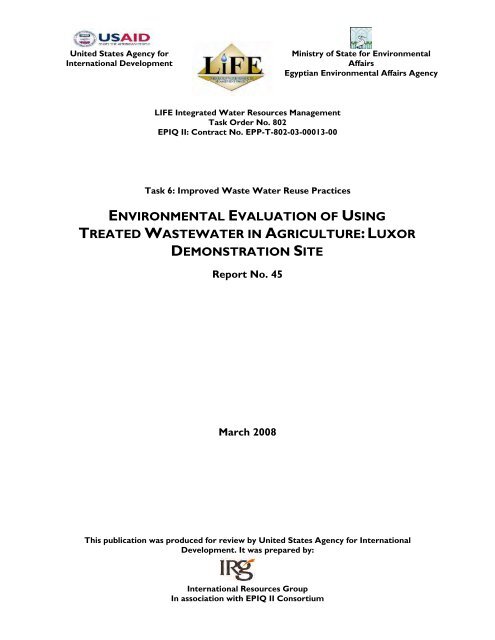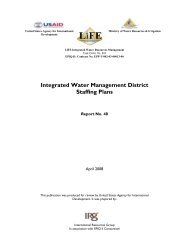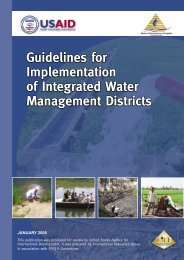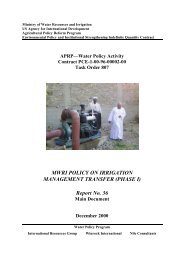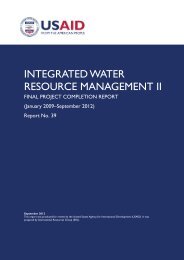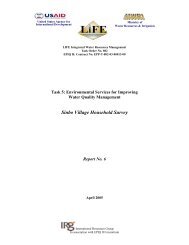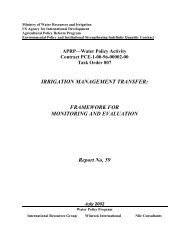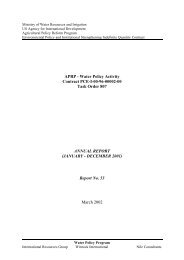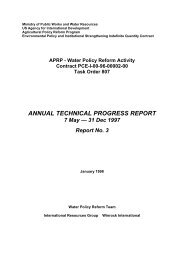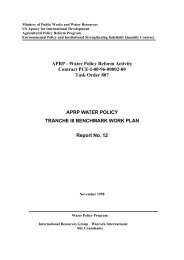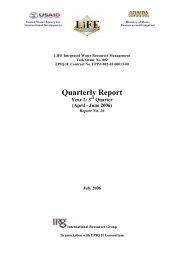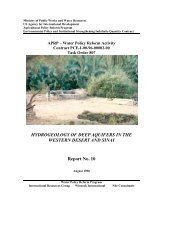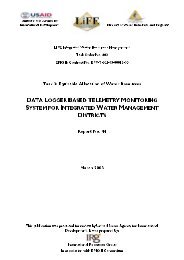Report 45 Task 6 Environmental Evaluation Luxor Demo Site
Report 45 Task 6 Environmental Evaluation Luxor Demo Site
Report 45 Task 6 Environmental Evaluation Luxor Demo Site
Create successful ePaper yourself
Turn your PDF publications into a flip-book with our unique Google optimized e-Paper software.
United States Agency for<br />
International Development<br />
Ministry of State for <strong>Environmental</strong><br />
Affairs<br />
Egyptian <strong>Environmental</strong> Affairs Agency<br />
LIFE Integrated Water Resources Management<br />
<strong>Task</strong> Order No. 802<br />
EPIQ II: Contract No. EPP-T-802-03-00013-00<br />
<strong>Task</strong> 6: Improved Waste Water Reuse Practices<br />
ENVIRONMENTAL EVALUATION OF USING<br />
TREATED WASTEWATER IN AGRICULTURE: LUXOR<br />
DEMONSTRATION SITE<br />
<strong>Report</strong> No. <strong>45</strong><br />
March 2008<br />
This publication was produced for review by United States Agency for International<br />
Development. It was prepared by:<br />
International Resources Group<br />
In association with EPIQ II Consortium
US Agency<br />
for International Development<br />
Ministry of State for <strong>Environmental</strong> Affairs<br />
Egyptian <strong>Environmental</strong> Affairs Agency<br />
LIFE Integrated Water Resources Management<br />
<strong>Task</strong> Order No. 802<br />
EPIQ II: Contract No. EPP-T-802-03-00013-00<br />
<strong>Task</strong> 6: Improved Waste Water Reuse Practices<br />
ENVIRONMENTAL EVALUATION OF USING<br />
TREATED WASTEWATER IN AGRICULTURE: LUXOR<br />
DEMONSTRATION SITE<br />
<strong>Report</strong> No. <strong>45</strong><br />
This report was prepared by ECODIT, Inc.<br />
March 2008<br />
DISCLAIMER<br />
The authors views expressed in this publication do not necessarily reflect the views of the United<br />
States Agency for International Development or the United States Government
<strong>Task</strong> 6. <strong>Environmental</strong> <strong>Evaluation</strong> of Using Treated Wastewater in Agriculture<br />
ACKNOWLEDGEMENTS<br />
This report was undertaken as a joint activity of the Ministry of State for <strong>Environmental</strong> Affairs<br />
(MSEA), Egyptian <strong>Environmental</strong> Affairs Agency (EEAA), and the Livelihood and Income from the<br />
Environment–Integrated Water Resources Management Project (LIFE–IWRM) Team.<br />
The LIFE–IWRM is a joint activity of the Ministry of Water Resources and Irrigation (MWRI),<br />
Ministry of State for <strong>Environmental</strong> Affairs (MSEA), and the United States Agency for International<br />
Development (USAID) and is being implemented by a consortium led by International Resources<br />
Group, Ltd. (IRG).<br />
In particular, the LIFE–IWRM Chief of Party, Dr. Jeffery Fredericks; <strong>Task</strong> 6 Manager, Dr. Wadie<br />
F. Mankarious; the LIFE IWRM team; and Karim El-Jisr, ECODIT Consultant; would like to<br />
acknowledge the contributions and support of the management and staff of MSEA/EEAA, MALR and<br />
MWRI. Policy and technical guidance provided by the following individuals was significant and greatly<br />
appreciated:<br />
• Dr. Mawaheb Abu Elazm, Chairperson of EEAA / MSEA<br />
• Dr. Moustafa El Hakeem, Afforestation Consultant, EEAA, and Technical Advisor to the<br />
Minister<br />
• Eng. Mohamed Ahmed Moustafa, Under Secretary for Reforestation and Environment,<br />
MALR<br />
• Eng. Mohamed Hamed, MWRI<br />
• Eng. Wafaa Faltaous, Cognizant Technical Officer (CTO) for the project, USAID.<br />
LIFE–IWRM i INTERNATIONAL RESOURCES GROUP
<strong>Task</strong> 6. <strong>Environmental</strong> <strong>Evaluation</strong> of Using Treated Wastewater in Agriculture<br />
TABLE OF CONTENTS<br />
Acknowledgements ........................................................................................................................ i<br />
Table of Contents .......................................................................................................................... ii<br />
List of Tables ............................................................................................................................... iii<br />
List of Figures .............................................................................................................................. iii<br />
Acronyms and Abbreviations .................................................................................................... iv<br />
Executive Summary ...................................................................................................................... 1<br />
1. Introduction ...................................................................................................................... 2<br />
1.1. Background .................................................................................................................... 2<br />
1.2. Purpose ............................................................................................................................... 2<br />
1.3. Methodology .................................................................................................................... 2<br />
1.4. <strong>Report</strong> Organization ......................................................................................................... 2<br />
2. <strong>Environmental</strong> evaluation ............................................................................................... 3<br />
2.1. <strong>Site</strong> Description ............................................................................................................... 3<br />
2.2. Group 1: Treated Wastewater .......................................................................................... 5<br />
2.2.1. Baseline................................................................................................................ 5<br />
2.2.2. Water Quantity Monitoring Results ...................................................................... 5<br />
2.2.3. Water Quality Monitoring Results ......................................................................... 6<br />
2.3. Group 2: Soil .................................................................................................................... 6<br />
2.3.1. Baseline................................................................................................................ 6<br />
2.3.2. Monitoring results ................................................................................................ 7<br />
2.4. Group 3: Groundwater .................................................................................................... 8<br />
2.4.1. Baseline................................................................................................................ 8<br />
2.4.2. Monitoring results ................................................................................................ 9<br />
2.5. Group 4: Crops ................................................................................................................ 9<br />
2.5.1. Baseline................................................................................................................ 9<br />
2.5.2. Monitoring Results ............................................................................................. 10<br />
2.6. Group 5: Health and Safety ............................................................................................. 12<br />
2.6.1. Baseline.............................................................................................................. 12<br />
2.6.2. Monitoring Results ............................................................................................. 12<br />
3. Conclusions and recommendations ............................................................................. 13<br />
3.1. Conclusions .................................................................................................................. 13<br />
3.2. Recommendations .......................................................................................................... 13<br />
3.2.1. End-Users .......................................................................................................... 13<br />
3.2.2. Government of Egypt ......................................................................................... 13<br />
LIFE–IWRM ii INTERNATIONAL RESOURCES GROUP
<strong>Task</strong> 6. <strong>Environmental</strong> <strong>Evaluation</strong> of Using Treated Wastewater in Agriculture<br />
List of Tables<br />
Table 1 Summary of <strong>Environmental</strong> Monitoring Plan in <strong>Luxor</strong> ................................................................ 3<br />
Table 2 Monitoring Laboratories and Facilities ........................................................................................... 3<br />
Table 3 Limit Values for Treated Municipal Wastewater Reused in Agriculture (mg/l) .................... 5<br />
Table 4 Initial Effluent Test Results from Lagoon (baseline) ..................................................................... 5<br />
Table 5 Summary of Tests Conducted on TWW ..................................................................................... 6<br />
Table 6 Summary of Soil Tests ....................................................................................................................... 7<br />
Table 7 Complete Soil Tests Results ............................................................................................................. 8<br />
Table 8 Summary of Groundwater Tests ..................................................................................................... 9<br />
Table 9 Approved Crop List Irrigated with Treated Wastewater .......................................................... 10<br />
Table 10 <strong>Luxor</strong> <strong>Demo</strong> Crops ......................................................................................................................... 10<br />
Table 11 Summary of Crop Tests .................................................................................................................. 11<br />
Table 12 Risk Reduction Measures for Farm Workers, Crop Handlers and Graduates .................... 12<br />
List of Figures<br />
Figure 1: Location Map .........................................................................................................................................4<br />
Figure 2 Irrigation System Layout .....................................................................................................................4<br />
Figure 3: General Map Of The <strong>Demo</strong> <strong>Site</strong> And Surrounding Wells ..........................................................8<br />
Figure 4 Crop Layout ............................................................................................................................................11<br />
LIFE–IWRM iii INTERNATIONAL RESOURCES GROUP
<strong>Task</strong> 6. <strong>Environmental</strong> <strong>Evaluation</strong> of Using Treated Wastewater in Agriculture<br />
ACRONYMS AND ABBREVIATIONS<br />
AAU<br />
AED<br />
APRP<br />
ASC<br />
BCWUA<br />
BOD<br />
C<br />
CAD<br />
CD<br />
CDA<br />
CLAC<br />
CLEQM<br />
COD<br />
CTO<br />
CY<br />
DAI<br />
EEAA<br />
EEPP<br />
EMP<br />
EPADP<br />
EPIQ<br />
ET<br />
FC<br />
GB<br />
GIS<br />
GOE<br />
GPS<br />
GW<br />
GWS<br />
HD<br />
hp<br />
IAS<br />
IBRD<br />
ID<br />
IDS<br />
IIIMP<br />
IIP<br />
IRG<br />
IRMU<br />
IRs<br />
IRU<br />
IS<br />
IT<br />
IWMD<br />
IWMU<br />
IWRM<br />
IWRMP<br />
Agricultural Administrative Unit<br />
Academy for Educational Development (a US-based entity providing USAID-funded<br />
assistance regarding environmental education and awareness)<br />
Agricultural Policy Reform Program<br />
Alliance Steering Committee<br />
Branch Canal Water User Association<br />
Biological Oxygen Demand<br />
Centigrade<br />
Computer aided design<br />
Central Directorate<br />
Community Development Association<br />
Central Lab for Agricultural Climate<br />
Central Laboratory for <strong>Environmental</strong> Quality Monitoring (MWRI)<br />
Chemical oxygen demand<br />
Cognizant Technical Officer (the USAID person responsible for supervising a technical<br />
assistance contractor)<br />
Calendar Year<br />
Development Alternatives, Inc. (a Washington DC-based consulting firm working with<br />
IRG to implement the project)<br />
Egyptian <strong>Environmental</strong> Affairs Agency<br />
Egyptian <strong>Environmental</strong> Policy Program (a USAID-funded program aimed at achieving<br />
environmental policy reform)<br />
<strong>Environmental</strong> Monitoring Plan<br />
Egyptian Public Authority for Drainage Projects (MWRI)<br />
<strong>Environmental</strong> Policy and Institutional Strengthening Indefinite Quantity Contract<br />
Evapotranspiration<br />
Field Capacity<br />
Gigabyte<br />
Geographic Information System<br />
Government of Egypt<br />
Global Positioning System<br />
Groundwater<br />
Groundwater Sector<br />
(Aswan) High Dam<br />
Horsepower<br />
Irrigation Advisory Service<br />
International Bank for Reconstruction and Development or World Bank<br />
Irrigation Department<br />
Irrigation and Drainage System<br />
Integrated Irrigation Improvement and Management Project<br />
Irrigation Improvement Project<br />
International Resources Group (a Washington DC-based consulting firm that is prime<br />
contractor for the IWRMP)<br />
Integrated Water Management Unit<br />
Intermediate Results<br />
MWRI Institutional Reform Unit<br />
Information Systems<br />
Information Technology<br />
Integrated Water Management District<br />
Integrated Water Management Unit (A unit of MWRI)<br />
Integrated Water Resources Management<br />
Integrated Water Resource Management Project<br />
LIFE–IWRM iv INTERNATIONAL RESOURCES GROUP
<strong>Task</strong> 6. <strong>Environmental</strong> <strong>Evaluation</strong> of Using Treated Wastewater in Agriculture<br />
jpg, jpeg<br />
KB<br />
kg<br />
LAN<br />
LIFE<br />
LOE<br />
M&E<br />
MALR<br />
MED<br />
mg/l<br />
MIC<br />
MISD<br />
MOE<br />
MOHP<br />
MOU<br />
MSEA<br />
MWH<br />
MWRI<br />
NASA<br />
NGO<br />
NPK<br />
NSCE<br />
NWRC<br />
O&M<br />
OJT<br />
PC<br />
pH<br />
PM&E<br />
ppm<br />
PWP<br />
RSC/WP<br />
RWS<br />
SIRs<br />
SOs<br />
SS<br />
STTA<br />
SWERI<br />
TA<br />
TDS<br />
TOR<br />
TRG<br />
TS<br />
TSS<br />
TWW<br />
UPS<br />
USAID<br />
USB<br />
WCU<br />
WDC<br />
WPRP<br />
WQU<br />
WUA<br />
WWTP<br />
Joint Photographic Expert Group (computing)<br />
Kilobyte<br />
Kilogram(s)<br />
Local Area Network<br />
Livelihood and Income from the Environment (project)<br />
Level of Effort<br />
Monitoring and <strong>Evaluation</strong><br />
Ministry of Agriculture and Land Reclamation<br />
MWRI Mechanical & Electrical Department<br />
milligrams per liter<br />
MWRI Ministry Information Center<br />
Matching Irrigation Supply and Demand<br />
Ministry of Education<br />
Ministry of Health and Population<br />
Memorandum of Understanding<br />
Ministry of Sate for <strong>Environmental</strong> Affairs<br />
Montgomery Watson Harza<br />
Ministry of Water Resources and Irrigation<br />
(United States) National Aeronautics and Space Administration<br />
Non-governmental Organization<br />
nitrogen, phosphorus, and potassium (especially in chemical fertilizers)<br />
North South Consultants Exchange<br />
(MWRI) National Water Research Center<br />
Operation and Maintenance<br />
On-the-Job Training<br />
Personal Computer<br />
Potential of Hydrogen ions (measure of acidity or alkalinity)<br />
Performance Monitoring and <strong>Evaluation</strong><br />
Parts per Million<br />
Permanent Wilting Point<br />
Red Sea Coastal/Water Project (short name for USAID-funded Red Sea Coastal and<br />
Improved Water Resource Management Project)<br />
Relative Water Supply<br />
Sub-Intermediate Results<br />
Strategic Objectives<br />
Suspended Solids<br />
Short-term Technical Assistance<br />
Soils, Water, and Environment Research Institute (MALR)<br />
Technical assistance<br />
Total Dissolved Solids<br />
Terms of Reference<br />
Training Resources Group<br />
Transition State (chemical)<br />
Total Suspended Solids<br />
Treated Wastewater<br />
Uninterruptible Power Supply Device<br />
United States Agency for International Development<br />
Universal Serial Bus (computing)<br />
MWRI Water Communication Unit<br />
MWRI Central Water Distribution Center<br />
Water Resources Results Package<br />
MWRI Water Quality Unit<br />
Water User Association<br />
Wastewater Treatment Plant<br />
LIFE–IWRM v INTERNATIONAL RESOURCES GROUP
<strong>Task</strong> 6. <strong>Environmental</strong> <strong>Evaluation</strong> of Using Treated Wastewater in Agriculture<br />
EXECUTIVE SUMMARY<br />
LIFE Integrated Water Resources Management Project has demonstrated the technical feasibility of<br />
reusing treated wastewater (TWW) in agriculture in a manner that is environmentally safe and<br />
compliant. The Project managed a 10-Feddan water reuse site in <strong>Luxor</strong> located near the new<br />
wastewater treatment plant. The site received treated wastewater from the nearest maturation<br />
pond and produced a number of commercial crops including flax, cut flowers and ornamental plants,<br />
Jojoba, Jatropha, and Sorghum. The first plantation started in winter 2005. The crops were selected<br />
according to the list posted under Grade-B of treated wastewater in the Egyptian Code for Reuse of<br />
Treated Wastewater in Agriculture.<br />
This report presents an environmental evaluation of the demo site, two years after the demo site<br />
was established. The evaluation examined five monitoring groups:<br />
Treated wastewater (physical, chemical and biological parameters);<br />
• Soil;<br />
• Groundwater;<br />
• Crops; and<br />
• Health & Safety.<br />
The results show that:<br />
• Reusing treated wastewater (Grade B) in agriculture is safe provided precautions are taken<br />
and followed through<br />
• Two years of continued irrigation using TWW showed no adverse impacts on soil, plant,<br />
groundwater and health.<br />
• Because the project timeframe was short, longer-term monitoring would be required to<br />
confirm the results.<br />
This report also presents a set of recommendations for reuse of treated wastewater in agriculture.<br />
Recommendations for End-Users include:<br />
• Use advanced irrigation techniques (minimize flood irrigation) on sandy soils<br />
• Improve soil fertility if using treated wastewater on new lands.<br />
• Implement risk reduction measures for farm workers and crop handlers.<br />
• Implement basic self monitoring tests.<br />
• Recommendations for the Government of Egypt include:<br />
• More graduate training on water reuse practices.<br />
• Disseminate pertinent findings on water reuse (EEAA newsletter, TV, journals).<br />
• Monitor the long-term effects of water reuse on biodiversity (especially birds, mammals,<br />
and reptiles).<br />
LIFE IWRM 1<br />
INTERNATIONAL RESOURCES GROUP
<strong>Task</strong> 6. <strong>Environmental</strong> <strong>Evaluation</strong> of Using Treated Wastewater in Agriculture<br />
1. INTRODUCTION<br />
1.1. Background<br />
Egypt has been using treated wastewater to produce wood and other industrial products since the<br />
early 1990s. The Ministry of Agriculture and Land Reclamation (MALR) and the Ministry of State for<br />
<strong>Environmental</strong> Affairs (MSEA) have to date established 24 water-reuse projects across the country<br />
including one in <strong>Luxor</strong> where they grow African Mahogany (Khaya senegalensis), mulberry (Morus<br />
spp), and Physic Nut (Jatropha curcas). So far, these projects have been exclusively government<br />
driven and private sector participation is noticeably absent. An inter-ministerial committee approved<br />
in April 2005 the Egyptian Water Reuse Code (ministerial decree No. 171/2005).<br />
IRG and ECODIT designed <strong>Task</strong> #6 Improved Wastewater Reuse Practices under the LIFE<br />
Integrated Water Resources Management Project (LIFE IWRM) to demonstrate the technical<br />
feasibility of treated waste water reuse for irrigation in a manner that is environmentally safe and<br />
compliant. Over a period of two years, the Project managed a 10-Feddan water reuse site in <strong>Luxor</strong>,<br />
near the <strong>Luxor</strong> wastewater treatment plant. The site was irrigated using treated wastewater<br />
pumped from the nearest maturation pond. The project cultivated a number of commercial crops<br />
including Jojoba, Jatropha, Sorghum, Flax, cut flowers and ornamental plants.<br />
1.2. Purpose<br />
The purpose of this report is to review and interpret all test results obtained or collected during the<br />
project in relation to preset environmental monitoring parameters; treated wastewater,<br />
groundwater, soil, crops and occupational health. The report findings provide a solid basis for<br />
replicating water reuse projects on similar lands and under comparable climatic conditions.<br />
1.3. Methodology<br />
To prepare this report, the monitoring team:<br />
• Used the <strong>Environmental</strong> Monitoring Plan (EMP) for <strong>Task</strong> 6 which was prepared and<br />
approved in November 2005.<br />
• Consolidated and reviewed all test reports pertaining to treated wastewater, groundwater,<br />
soil, crops and worker’s health.<br />
• Visited the site in <strong>Luxor</strong> to discuss outstanding environmental issues with the local team.<br />
• Collected additional soil and groundwater samples to complete the environmental<br />
evaluation and sent those tests for analysis in <strong>Luxor</strong>.<br />
• Presented and discussed draft EMP findings with senior representatives from MSEA, MALR,<br />
MWRI and USAID, on 16/07/2007.<br />
1.4. <strong>Report</strong> Organization<br />
This report is organized into three chapters:<br />
1. Introduction<br />
2. <strong>Environmental</strong> <strong>Evaluation</strong><br />
3. Conclusions and Recommendations<br />
LIFE IWRM 2<br />
INTERNATIONAL RESOURCES GROUP
<strong>Task</strong> 6. <strong>Environmental</strong> <strong>Evaluation</strong> of Using Treated Wastewater in Agriculture<br />
2. ENVIRONMENTAL EVALUATION<br />
This <strong>Environmental</strong> <strong>Evaluation</strong> of Using Treated Wastewater in Agriculture is based on the<br />
<strong>Environmental</strong> Monitoring Plan (prepared by ECODIT) in November 2005. The Plan described five<br />
monitoring groups:<br />
1. Group 1: Treated wastewater (quantity, physical, chemical and bacteriological properties)<br />
2. Group 2: Soil<br />
3. Group 3: Groundwater<br />
4. Group 4: Crops<br />
5. Group 5: Workers’ Health<br />
Table 1 below summarizes the EMP including test parameters and frequency.<br />
Table 1 Summary of <strong>Environmental</strong> Monitoring Plan in <strong>Luxor</strong><br />
Group Parameters Frequency Laboratory<br />
Group 1: TWW Turbidity, BOD, COD, SS, DO,<br />
residual chlorine, oil & grease, heavy<br />
metals, nematode cells or eggs, E.<br />
Coli and/or total coliform<br />
Quarterly<br />
(increase frequency of<br />
test results show no<br />
compliance)<br />
CLEQM,<br />
MOHP Lab,<br />
And <strong>Luxor</strong><br />
WWTP Lab.<br />
Group 2: Soil Organic matter, macro & micronutrients,<br />
Bi-annual<br />
SWERI<br />
EC, alkalinity, heavy metals<br />
Group 3:<br />
Depth to water table, pH, EC, Bi-annual<br />
CLEQM<br />
Groundwater nitrates and fecal coliform<br />
Group 4: Crops Basis nutrients (N, P, K), total At harvest (crop SWERI<br />
Group 5: Health &<br />
Safety<br />
coliform and heavy metals<br />
Training on H&S<br />
• Information/warning<br />
signs<br />
• Medical check-up<br />
• Vaccination<br />
• Protective clothing<br />
• Record keeping<br />
specific)<br />
Year 2<br />
One-time (replace if necessary)<br />
Pre-employment<br />
Pre-employment<br />
Daily<br />
Weekly<br />
Facilities and laboratories used for environmental monitoring are presented in Table 2.<br />
Table 2 Monitoring Laboratories and Facilities<br />
Item<br />
Laboratory<br />
1 <strong>Luxor</strong> Wastewater Treatment Plant Lab (WWTP)<br />
2 Ministry of Agriculture and Land Reclamation / Central Lab for Food and Fodder (Giza)<br />
3 Ministry of Agriculture and Land Reclamation / Soil Lab (<strong>Luxor</strong>)<br />
4 Central Laboratory for <strong>Environmental</strong> Quality Monitoring (CLEQM) / MWRI<br />
5 El-Amal Medical Lab (<strong>Luxor</strong>)<br />
6 <strong>Luxor</strong> International Hospital<br />
7 Ministry of Health and Population Central Lab – Water Dept.<br />
2.1. <strong>Site</strong> Description<br />
The <strong>Luxor</strong> demo site is located on a 10 Feddan area located adjacent to the <strong>Luxor</strong> waste water<br />
treatment plant maturation ponds. Several other important features are located within a one km<br />
radius from the site including vast Jatropha plantations, at least three private wells (one of which is<br />
reportedly dry), Khaya plantations, and other units of the treatment plants including facultative<br />
LIFE IWRM 3<br />
INTERNATIONAL RESOURCES GROUP
<strong>Task</strong> 6. <strong>Environmental</strong> <strong>Evaluation</strong> of Using Treated Wastewater in Agriculture<br />
ponds and sludge drying beds. The site proper had never been cultivated prior to the construction<br />
of the demo site. A location map is shown in Figure 1<br />
The irrigation system consists of a pumping station with a design outflow of 60 m3/hour, a filtration<br />
unit, and a distribution network. The irrigation network is composed of a 125 mm main line, 75 mm<br />
sub-mains, 18 mm laterals, and different sizes of drippers. Figure 2 shows the layout of the demo site<br />
irrigation system<br />
Figure 1: Location Map<br />
Figure 2 Irrigation System Layout<br />
LIFE IWRM 4<br />
INTERNATIONAL RESOURCES GROUP
<strong>Task</strong> 6. <strong>Environmental</strong> <strong>Evaluation</strong> of Using Treated Wastewater in Agriculture<br />
2.2. Group 1: Treated Wastewater<br />
The <strong>Luxor</strong> demo site was designed to meet Grade B treated wastewater. The limit values for shortterm<br />
use (less than 20 years) of treated wastewater are presented in Table 3.<br />
Table 3 Limit Values for Treated Municipal Wastewater Reused in Agriculture (mg/l)<br />
Treatment Grade Requirements A B C<br />
Effluent limit values for<br />
BOD and SS<br />
BODs < 20 < 60 < 400<br />
SS < 20 < 50 < 250<br />
Effluent limit value for fecal<br />
coliform and Nematode<br />
cells or eggs (per liter)<br />
Fecal coliform<br />
count (2) in 100 cm 3<br />
Count of Nematode<br />
cells or eggs per<br />
liter<br />
* Egyptian Water Reuse Code (Grade B)<br />
< 1000 < 5000 Unspecified<br />
< 1 < 1 Unspecified<br />
2.2.1. Baseline<br />
The quality of the treated wastewater in the maturation (and polishing) lagoons was good and<br />
compliant before implementing the demo site. The <strong>Luxor</strong> Wastewater Treatment Plant (WWTP)<br />
environmental laboratory conducts routine sampling and analysis of the influent and effluent water.<br />
Standard tests include pH, alkalinity, TSS, TDS, TS, BOD, coliform and Chlorophyll A. At the<br />
request of LIFE, the WWTP laboratory agreed to collect and analyze daily samples from the lagoon<br />
over a period of one week in September 2005 (called baseline). Those test results are summarized<br />
in Table 4.<br />
Table 4 Initial Effluent Test Results from Lagoon (baseline)<br />
Temp pH BOD COD DO TDS TSS Coliform Count<br />
Average 30.2 8.17 25.8 32.8 7.58 466.4 29 3,060<br />
Source: Data provided by <strong>Luxor</strong> laboratory, September 2005<br />
2.2.2. Water Quantity Monitoring Results<br />
Continuous flow water meters were installed to measure daily flow discharges from the main and<br />
subsidiary irrigation distribution systems. A summary of the water delivered to the <strong>Luxor</strong> <strong>Demo</strong><br />
site are given in Annex B. A review of those readings shows that the demo site pumped in a single<br />
year (from 01/01/06 to 31/12/06) 127,000 m3 of treated wastewater from the pond. This is<br />
equivalent to 12,700 m3/feddan/year (assuming a total irrigated area of 10 Feddan). The highest<br />
quantity was recorded in January (11,940 m3) when all the plots were newly planted, and the lowest<br />
quantity was in February (7,590 m3). An agricultural field with similar soil and climatic conditions<br />
would on average consume between 5,000 (drip/sprinkler) to 7,000 (surface irrigation)<br />
m3/feddan/per year. The high initial water use can be attributed to the need for leaching of the soil<br />
and to the fact that several of the crops were irrigated using furrow and flood irrigation instead of<br />
drip. It is safe to conclude that irrigation efficiency in <strong>Luxor</strong> can be improved to reduce the total<br />
quantities of water pumped (whatever the source). Less water will minimize the risk of<br />
groundwater contamination but may require more leaching to offset the impact of accumulated salts.<br />
LIFE IWRM 5<br />
INTERNATIONAL RESOURCES GROUP
<strong>Task</strong> 6. <strong>Environmental</strong> <strong>Evaluation</strong> of Using Treated Wastewater in Agriculture<br />
2.2.3. Water Quality Monitoring Results<br />
Routine samples of TWW were collected from the treatment plant and sent to different<br />
laboratories for testing during the program. Table 5 presents summary of the test schedule.<br />
Table 5 Summary of Tests Conducted on TWW<br />
Laboratory Date of Sampling Parameters<br />
<strong>Luxor</strong> WWTP* Routine (every 10 days) BOD, COD, TSS, total coliform<br />
Central Lab for <strong>Environmental</strong><br />
Quality Monitoring (MWRI)<br />
2005: May, Sep<br />
2006: Feb, Mar, Aug, Nov, Dec<br />
Physiochemical, major cations<br />
and anions, trace metals,<br />
microbiological<br />
Ministry of Public Health 2007: Mar, May BOD, COD, TDS, TSS<br />
(MOHP)<br />
* Samples collected by the WWTP personnel<br />
In the period from September 2005 (baseline) through June 2007, the quality of the TWW was<br />
generally compliant, below or near Egyptian limit values, for Grade B under the Egyptian Water<br />
Reuse Code.<br />
To minimize travel distance, it was decided during later stages of the pilot project to conduct water<br />
sample analysis at the water lab of the Ministry of Health and Population, in <strong>Luxor</strong>. Those tests,<br />
while not complete (total coliform was missing), produced BOD and TSS results that were slightly<br />
higher than the results reported by the WWTP lab or CLEQM. Those values were also slightly<br />
above their limit value. For example:<br />
• BOD was 69-104 mg/l (std is 60)<br />
• TSS was 64-140 mg/l (std is 50)<br />
A comparison of the values for turbidity and TSS before and after the filtration units showed an<br />
appreciable drop in those values. For example:<br />
• Turbidity dropped from 7.89 to 5.14 NTU (Mar 2006)<br />
• TSS dropped from 132 to 92 mg/l (Aug 2006)<br />
• Turbidity dropped from 18.3 to 8.34 NTU (Nov 2006)<br />
The sand filters are therefore reducing suspended solids in treated wastewater and help prevent<br />
clogging in the irrigation network.<br />
2.3. Group 2: Soil<br />
2.3.1. Baseline<br />
In October 2005, the Project collected 24 soil samples from eight locations inside the demo site and<br />
from three different depths (0-30, 30-60, 60-90). The samples were analyzed at the MARL lab in<br />
Cairo: 1 physical tests were conducted on all 24 samples (8 locations) and chemical tests were<br />
conducted on 9 samples (3 locations). Physical tests include particle size distribution and chemical<br />
tests include: pH, electrical conductivity, anions and cations, CaCO 3, organic matter, and macro and<br />
micro nutrients. The soil in <strong>Luxor</strong> prior to the construction of the demo site had the following<br />
characteristics:<br />
• Texture: soil is loamy sand to sandy (>90 percent sand)<br />
1 Ministry of Agriculture/Agricultural Research Centre/Soils, Water & Environment Research Institute (SWERI)/Unit of<br />
Analysis & Studies. Giza, Cairo.<br />
LIFE IWRM 6<br />
INTERNATIONAL RESOURCES GROUP
<strong>Task</strong> 6. <strong>Environmental</strong> <strong>Evaluation</strong> of Using Treated Wastewater in Agriculture<br />
• Alkalinity: high, pH ranged from 8.05 to 8.<strong>45</strong><br />
• Electrical Conductivity: moderate to high (about 5 dS/m)<br />
• Organic matter: very low (expected), OM ranges from 0.03 to 0.53 percent<br />
• Macronutrients: Nitrogen (N) was 60-120 ppm, Phosphorous (P) was 1-5 ppm, and<br />
Potassium (K) was 80-170 ppm<br />
2.3.2. Monitoring results<br />
Partial soil tests were conducted in October 2006 (to investigate the causes of poor growth in the<br />
sorghum plot) and a complete soil test was in July 2007. Table 6 presents a summary of the test<br />
program.<br />
Table 6 Summary of Soil Tests<br />
Laboratory<br />
Date of<br />
Sampling<br />
Sampling Method<br />
Regional lab for soil October 2006 One sample only from<br />
fertility, <strong>Luxor</strong> (MALR)<br />
sorghum plot (depth 0-30)<br />
Regional lab for soil July 2007 Samples collected from 3<br />
fertility, <strong>Luxor</strong> (MALR)<br />
locations (A, B, C) and from<br />
three different depths (0-30,<br />
30-60, 60-90), plus one<br />
composite sample (0-30)<br />
Parameters<br />
pH, percent salts,<br />
CaCO3, major cations<br />
and anions, and macro<br />
nutrients (Nitrogen,<br />
Phosphorous,<br />
Potassium)<br />
The sample collected from the sorghum plot in October 2006 showed that:<br />
• N had dropped from 60-120 ppm (baseline) to 10 ppm just before harvesting the crop;<br />
• P had increased from 1-5 ppm (baseline) to 22 ppm before harvesting the crop; and<br />
• K had remained unchanged (130 ppm compared to 80-170 prior to planting).<br />
It can be concluded that one sorghum cycle depleted soil nutrient reserves; that soil fertility, already<br />
low before planting, had declined even further. This is not surprising considering that the soil is<br />
sandy (and therefore has a very low cation exchange capacity) and soil organic matter is close to nil<br />
(organic matter preserves soil moisture and prevents nutrient leaching). Excess irrigation may have<br />
contributed to reducing soil fertility as excess water will leach sandy soils and thereby displace soil<br />
nutrients. While wastewater will bring nutrients to the soil, wastewater cannot replenish or restore<br />
soil nutrient reserves without adequate soil management practices. As stated by the Ministry of<br />
Agriculture and Land Reclamation: improving soil fertility in reclaimed lands in Egypt requires a<br />
battery of soil conditioners including: 2<br />
• Manure: about 20 m3 per feddan (followed by deep tilling)<br />
• Sulfur: about 1 tone per feddan (followed by deep tilling)<br />
• Commercial fertilizer (NPK)<br />
• Micronutrients: based on soil conditions and crop requirements<br />
The full tests conducted at the demo site in <strong>Luxor</strong> in July 2007 showed that:<br />
• Alkalinity had remained high, pH ranged from 8.2 to 8.9<br />
• Total dissolved salts had dropped (from 0.03% to 0.2%)<br />
• Nitrogen had dropped to 20-40 ppm<br />
• Phosphorous & Potassium had increased slightly to 6-9 ppm and 140-242 ppm, respectively<br />
Table 7 shows the full results of the soil tests.<br />
2 Translated and adapted from the MARL test report (Regional Lab for Soil Fertility)<br />
LIFE IWRM 7<br />
INTERNATIONAL RESOURCES GROUP
<strong>Task</strong> 6. <strong>Environmental</strong> <strong>Evaluation</strong> of Using Treated Wastewater in Agriculture<br />
Table 7 Complete Soil Tests Results<br />
Plot Depth (cm) pH<br />
TDS<br />
CaCO<br />
(%)<br />
3<br />
K Na Mg CA So4 Ci Hco3<br />
A 0-30 8.3 0.08 14.4 0.3 1.6 0.4 1.5 2.7 0.44 0.66<br />
30-60 8.2 0.1 18.5 0.2 2.04 0.6 2.2 3.94 0.44 0.66<br />
60-90 8.6 0.2 10.3 0.2 3.4 1.7 3.7 7.9 0.44 0.66<br />
B 0-30 8.4 0.1 11.9 0.2 1.8 1.4 2.2 4.5 0.44 0.66<br />
30-60 8.9 0.1 13.2 0.2 2.5 1.4 2.2 4.98 0.44 0.88<br />
60-90 8.4 0.1 22.2 0.2 2.8 0.4 3.5 5.36 0.66 0.88<br />
C 0-30 8.2 0.05 18.5 0.3 0.9 0.5 1.3 5.58 0.66 0.66<br />
30-60 8.8 0.03 20.6 0.2 0.8 0.3 1.3 1.28 0.44 0.88<br />
60-90 8.8 0.03 17.7 0.2 0.7 0.3 1.3 0.96 0.88 0.66<br />
Composite 8.3 0.1 15.6 0.5 2.5 0.4 3.3 4.94 1.1 0.66<br />
2.4. Group 3: Groundwater<br />
2.4.1. Baseline<br />
In February 2005, the Project collected a groundwater sample from a 20-meter deep (production)<br />
well located 1 km west of the demo site, near the forested area. The sample was analyzed at<br />
CLEQM (MWRI). Test results indicated no fecal contamination. According to Mr. Salah Eldine<br />
Ramadan, Director of the Soil Fertility Lab in <strong>Luxor</strong> (MARL), “groundwater in <strong>Luxor</strong> in the area of<br />
the demo site [area also known as “Hbail”] is moderately to highly saline.” TDS values from<br />
neighboring farms ranged from 900 - 4,000 (1.4 to 6.25 dS/m). Figure 3 shows the demo site and<br />
surrounding wells.<br />
Figure 3: General Map of the <strong>Demo</strong> <strong>Site</strong> and Surrounding Wells<br />
LIFE IWRM 8<br />
INTERNATIONAL RESOURCES GROUP
<strong>Task</strong> 6. <strong>Environmental</strong> <strong>Evaluation</strong> of Using Treated Wastewater in Agriculture<br />
2.4.2. Monitoring results<br />
An observation well was constructed inside the demo site. Groundwater samples were collected on<br />
three different dates. Table 8 presents an overview of groundwater samples collected onsite and<br />
the date of sampling.<br />
Table 8 Summary of Groundwater Tests<br />
Location<br />
Date<br />
Chloride<br />
(mg/l)<br />
Alkalinity<br />
(mg/l)<br />
Ph<br />
Conduct.<br />
EC (Ds/m)<br />
Tss<br />
(mg/l)<br />
Ts<br />
(mg/l)<br />
Total<br />
Coliform<br />
(CFU/ml)<br />
On-site 340 140 6.9 4651 88 4192 700<br />
July 14, 2007<br />
Man-made<br />
forest<br />
80 810 7.4 1864 61 1678 0<br />
On-site 312 200 7.5 6750 136 4<strong>45</strong>5 600<br />
August 6, 2007<br />
Man-made<br />
forest<br />
80 1220 8.02 1840 50 1376 0<br />
On-site 360 160 6.8 4670 90 4200 800<br />
September 15, 2007<br />
Man-made<br />
forest<br />
72 780 7.3 1856 60 1670 0<br />
On-site 350 135 6.8 <strong>45</strong>63 85 4165 700<br />
October 14, 2007<br />
Man-made<br />
forest<br />
75 800 7.4 1855 58 1668 0<br />
On-site 180 140 8.18 5200 46 3<strong>45</strong>8 0<br />
November 25, 2007<br />
Man-made<br />
forest<br />
80 240 8.17 1750 40 794 0<br />
On-site 355 155 6.9 <strong>45</strong>20 90 4100 800<br />
December 17, 2007<br />
Man-made<br />
forest<br />
65 420 7.2 1740 55 1570 0<br />
On-site 320 220 7.6 6720 140 4460 0<br />
January 20, 2008<br />
Man-made<br />
forest<br />
76 1180 8.03 1780 48 1380 0<br />
Groundwater salinity as expected is high. This however cannot be attributed to the demo site<br />
because salinity was high before planting and TDS (total dissolved salts) values in treated wastewater<br />
were generally low to moderate.<br />
Coliform were present in some of the samples taken at the on-site well during several of the tests.<br />
The reasons are not know.<br />
2.5. Group 4: Crops<br />
2.5.1. Baseline<br />
The Project Committee selected five demonstration crops from Grade B & C of the Egyptian Water<br />
Reuse Code) for the demo site: flowers and ornamentals, flax, Jojoba, sorghum, and Jatropha, Crop<br />
selection was based on a number of factors:<br />
LIFE IWRM 9<br />
INTERNATIONAL RESOURCES GROUP
<strong>Task</strong> 6. <strong>Environmental</strong> <strong>Evaluation</strong> of Using Treated Wastewater in Agriculture<br />
• Water quality of the treated waste water<br />
• Climate and soil conditions<br />
• EEAA and MALR interests<br />
• Marketing and economic considerations.<br />
Table 9 Approved Crop List Irrigated with Treated Wastewater<br />
Grade Agricultural Group Recommendations<br />
G2-1: Fodder/Feed Crops<br />
Sorghum sp<br />
G2-2: Trees producing fruits with epicarp On condition that they are produced for<br />
processing purposes, such as lemons,<br />
mangoes, date palms and almonds<br />
B<br />
G2-3: Trees used for green belts around<br />
cities and afforestation of highways or<br />
roads<br />
Casuarina, camphor, Athel tamarix (salt<br />
tree), oleander, fruit-producing trees, date<br />
palms, and olive trees<br />
G2-4: Nursery plants<br />
Nursery plants of wood trees, ornamental<br />
plants, and fruit trees<br />
G2-5: Roses and cut flowers<br />
Local roses, eagle roses, onions (e.g.<br />
gladiolus)<br />
G2-6: Fiber crops<br />
Flax, jute, hibiscus, sisal<br />
G2-7: Mulberry for the production of silk Japanese mulberry<br />
C<br />
G3-1: Industrial oil crops<br />
Jojoba and Jatropha<br />
G3-2: Wood trees<br />
Khaya, camphor, and other wood trees<br />
Source: Egyptian Water Reuse Code (Table 5-1, Page 20)<br />
The demonstration site was divided into 18 plots of equal size (0.5 feddan each). The Project also<br />
planted a green fence to mark the perimeter and to serve as windbreak. Figure 4 shows the<br />
distribution of the crops in the demo site.<br />
2.5.2. Monitoring Results<br />
Details on <strong>Luxor</strong> <strong>Demo</strong> Cropping dates and other relevant information are summarized in Table 10.<br />
Table 10 <strong>Luxor</strong> <strong>Demo</strong> Crops<br />
Crop<br />
Growth<br />
Period<br />
(days)<br />
Planting Date Harvest Date Cultivated Area Yields Unit Yield/unit<br />
Roses All year Jan-06 Weekly cuts 9 Karat<br />
From January 07 To Cut<br />
December 07 Roses/Karat In<br />
(25,723 Roses) Year<br />
Feb, Mar, Apr 07 Bird of Paradise 11 K 71 Flowers/ Karat 6<br />
Ornamentals All Year Jan-06<br />
Indian Fig 1.5 K<br />
N/A<br />
Golden Dewdrop 2 K<br />
N/A Trees sold/fd N/A<br />
Flax 5 months<br />
Winter 2005 May-06 1.8Fd 1.3 Ton 0.72<br />
Ton/Fd<br />
Winter 2006 May-07 2.5 Fd 6.47 Ton 2.59<br />
Jojoba Perennial Dec 2005 N/A 2 Fd N/A Kg/tree N/A<br />
Jatropha Perennial Nov-05 Summer 2007 1 Fd (496 Tree) 2<strong>45</strong> Kg Kg/tree 0.5<br />
Cut 1: June 06 Cut1: 10.19 Ton 5.10<br />
Sorghum 3-4 months Summer2006 Cut 2: August 06 Cut 2: 6.87 Ton 3.44<br />
Tons/fd<br />
Cut 3 : September 06 Cut 3 : no yield No yield<br />
Summer2007 Cut 1: June 07 12 Karat Cut 1: 2.4 Ton 4.7<br />
Olives Perennial Dec 2008 N/A 3 Fd N/A Kg/tree N/A<br />
Crop samples were collected from all the plots except Jatropha (see summary in Table 11). Jatropha<br />
trees need at least 3-5 years to produce its first mature fruits.<br />
2858<br />
LIFE IWRM 10<br />
INTERNATIONAL RESOURCES GROUP
<strong>Task</strong> 6. <strong>Environmental</strong> <strong>Evaluation</strong> of Using Treated Wastewater in Agriculture<br />
Figure 4 Crop layout<br />
Table 11 Summary of Crop Tests<br />
Date Lab Sample Parameters<br />
27-Jun-06 CLFF Flax seeds Total and fecal Coliform<br />
10-Jul-06 CLFF Flax seeds Total bacterial count, total<br />
Enterococcus, total fungal<br />
count, Norwolk Brius<br />
13-Jun-06 <strong>Luxor</strong> WWTP Flax seeds, foliage, stalk and roots Total Coliform<br />
13-Jun-06 <strong>Luxor</strong> WWTP Sorghum foliage, stem and roots Total Coliform<br />
19-Aug-06 <strong>Luxor</strong> WWTP Cow milk* Total Coliform<br />
30-Aug-06 CLFF Roses, durenta, sorghum, Flax<br />
dried seeds<br />
Total Bacterial count,<br />
Coliform count,<br />
Enterococcus count and<br />
total fungal count<br />
27-May-07 <strong>Luxor</strong> WWTP Flax: whole seeds, stem, roots, Total Coliform<br />
and crushed seeds<br />
14-Jun-07 <strong>Luxor</strong> WWTP Sorghum: roots, stem and foliage Total Coliform<br />
The test results showed that:<br />
1. Ornamental plants (roses and durenta), dried and crushed flax seeds, and cow milk showed<br />
no microbiological contamination. This result was expected as the harvested parts of the<br />
plant (buds and stems) do not come in direct contact with irrigation water.<br />
2. Sorghum stem and roots showed low levels of total coliform (700 and 4,000 CFU,<br />
respectively). This result can be expected considering that the sorghum is flood irrigated<br />
(furrows) and the green stems drop to the soil at harvest.<br />
LIFE IWRM 11<br />
INTERNATIONAL RESOURCES GROUP
<strong>Task</strong> 6. <strong>Environmental</strong> <strong>Evaluation</strong> of Using Treated Wastewater in Agriculture<br />
3. Flax seeds showed potentially dangerous fungi including Emericella nidulans (producing<br />
Strigmatocystin) and Fusarium verticilloides (producing Fumonesins). The source of the<br />
fungi could not be determined and cannot be attributed to TWW without further<br />
investigations.<br />
2.6. Group 5: Health and Safety<br />
The Project hired graduates to run the demo site (5 graduates the first year and 7 new graduates<br />
during the second year). The rationale behind this was to provide on-the-job training for farmers and<br />
agricultural students so as to increase the pool of individuals with practical skills in wastewater<br />
reuse. This way, LIFE would be able to ensure a gradual transfer of the demo site to the Ministry of<br />
Agriculture and Land Reclamation at the end of the Project.<br />
2.6.1. Baseline<br />
All the five graduates of the first group were sent for a medical check up in February 2006 (about<br />
one month after starting to work in the demo site). The check-up was conducted at two facilities:<br />
1. El Amal Medical Lab in <strong>Luxor</strong> for Hepatitis A and B tests, and<br />
2. <strong>Luxor</strong> International Hospital for parasites and microbiological tests<br />
The results indicated that the five graduates tested positive for Hepatitis A but negative on all other<br />
tests. Hepatitis A is both food and water born and therefore quite common in Egypt -the graduates<br />
may have contracted the virus before starting work on site.<br />
In June 2007, seven new graduates were recruited to replace the first group of graduates working at<br />
the demo site, and two from the first group remained thus bringing the total number of students to<br />
nine. The new graduates also had a complete medical check-up and they received a formal training<br />
course on Treated Wastewater Reuse Practices.<br />
2.6.2. Monitoring Results<br />
A second medical check-up of the graduates was conducted in February 2007 (by that time, there<br />
were only four graduates). All four graduates tested negative for parasites (Ancylostoma, Ascaris<br />
and Amoeba), infectious diseases (Typhoid and para-Typhoid), as well as Hepatitis A (HAV-IgG) and<br />
B (HAV-IgM).<br />
Risk reduction measures implemented at the demo site are presented in Table 12.<br />
Table 12 Risk Reduction Measures for Farm Workers, Crop Handlers and Graduates<br />
Measures<br />
Training<br />
Information signs<br />
Vaccination<br />
Protective boots<br />
& gloves<br />
Medical Checkup<br />
Implementation in <strong>Luxor</strong><br />
Organize targeted training program to sensitize farm workers on water reuse hazards and<br />
best protection measures<br />
Install information/warning signs at suitable locations to caution farm workers and remind<br />
them of safety measures<br />
Vaccinate farm workers according to MOHP requirements for sanitation workers involved<br />
in treatment plants and networks<br />
Provide workers with adequate protective boots and gloves, as well as first aid kit and a<br />
dedicated wash room.<br />
Conduct regular medical checkup and lab tests to detect potential infectious diseases<br />
related to water reuse (every 6 months)<br />
Pursuant to the Code, irrigation must stop two weeks prior to harvest to minimize<br />
Stop irrigation<br />
contaminant exposure by crop harvesters.<br />
Source: Adapted from Egypt’s Water Reuse Code (ministerial decree No. 171/2005)<br />
LIFE IWRM 12<br />
INTERNATIONAL RESOURCES GROUP
<strong>Task</strong> 6. <strong>Environmental</strong> <strong>Evaluation</strong> of Using Treated Wastewater in Agriculture<br />
3. CONCLUSIONS AND RECOMMENDATIONS<br />
3.1. Conclusions<br />
The major conclusions derived from the demo site in <strong>Luxor</strong> are as follows:<br />
• Reuse of treated wastewater (Grade B) in agriculture is safe provided precautions are taken<br />
and followed through;<br />
• Reuse of treated wastewater in the <strong>Luxor</strong> demo site did not show any adverse impacts on<br />
plant or health during the project period (2 years); and<br />
• Impact on soil and groundwater could not be detected within the project’s short timeframe<br />
and therefore would require longer-term monitoring. However, during this short time no<br />
adverse impact on soil or groundwater was detected.<br />
3.2. Recommendations<br />
Several recommendations were formulated based on the <strong>Luxor</strong> demo site. These recommendations<br />
were divided into two groups: recommendations for (i) end-users and (ii) the Government of Egypt.<br />
3.2.1. End-Users<br />
• Use advanced irrigation techniques (minimize flood irrigation). While surface (furrow)<br />
irrigation is allowed under the Egyptian Water Reuse Code, it is preferable to use drip<br />
irrigation to minimize deep percolation and prevent groundwater contamination (as well as<br />
leaching of nutrients) especially in sandy soils.<br />
• Improve soil fertility when reclaiming new soils. Sandy soils are very nutrient poor and<br />
do not hold moisture or nutrients well. If treated wastewater is used on new soils, it is<br />
recommended to improve soil fertility by applying soil conditioners (manure) and/or<br />
chemical fertilizer such as NPK and sulfur. The soil should also be leached to remove salts<br />
and deep tilled to loosen soil particles.<br />
• Adopt risk reduction measures for farm workers and crop handlers. It is<br />
imperative and a legal requirement to train workers and crop handlers on health and safety<br />
measures related to water reuse. Other risk reduction measures include<br />
information/warning signs and the use of protective clothing (gloves, overalls and boots).<br />
• Implement basic self monitoring tests and report results to MALR and EEAA. Reuse<br />
of treated wastewater in agriculture should be carefully monitored. The Egyptian Code for<br />
the Reuse of Treated Wastewater in Agriculture stipulates two levels of monitoring: selfmonitoring<br />
(to be conducted by the farm/project) and inspection (to be conducted by a<br />
regulatory body such as MALR and/or EEAA). It is equally important to disclose the test<br />
results.<br />
3.2.2. Government of Egypt<br />
• More graduate training. Egypt should increase the number of farmers/students who<br />
receive training in wastewater reuse for irrigation. The <strong>Luxor</strong> demo site trained 5<br />
graduates the first year and started training another 7 new graduates the second year.<br />
Establishing demo sites at existing waste water treatment facilities provides an excellent<br />
environment for on-the-job training. Such training could be facilitated by MALR and EEAA.<br />
• Disseminate pertinent findings on treated wastewater reuse (EEAA newsletter,<br />
TV, journals). It is important to explain the pros and cons of water reuse to farmers and<br />
potential investors through a national information campaign. Important messages related to<br />
LIFE IWRM 13<br />
INTERNATIONAL RESOURCES GROUP
<strong>Task</strong> 6. <strong>Environmental</strong> <strong>Evaluation</strong> of Using Treated Wastewater in Agriculture<br />
the opportunities and risks of water reuse can be communicated through newspapers,<br />
subject magazines and TV.<br />
• Monitor the long-term effects of water reuse on biodiversity (especially birds,<br />
mammals, and reptiles). Although plant cover is scarce in open deserts, desert ecosystems<br />
harbor important biodiversity in the form of reptiles and xeric plants. The demo site in<br />
question is part of a larger area that has already been significantly altered from years of<br />
water reuse and forest cultivation. Egypt must begin to assess the long-term effects of<br />
water reuse on biodiversity if it decides to implement large-scale irrigation projects using<br />
treated wastewater.<br />
LIFE IWRM 14<br />
INTERNATIONAL RESOURCES GROUP


